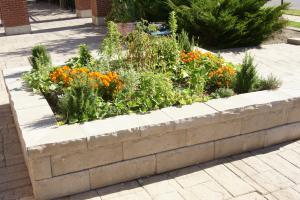May 1, 2011
Permaculture, the art of edible gardening
BY SEAN JAMESRecently I've been drawn into the world of permaculture, defined as growing your own food, preferably in a sustainable way. PLEASE! DON'T CLOSE THE PAGE! It's more relevant to professionals than you might think! This is an old concept brought back to life, and your potential customers have no clue how to do it anymore. I'll admit that learning the newest and most eco-friendly ways, along with an ever-expanding palette of plants, is a challenge, but everything should be a challenge if you're growing your abilities correctly.
It started as a little garden for a customer, then a smaller demo garden for Whole Foods, and is exploding from there. I always thought the permaculture/organic/local food people were a little wacky — like birders — interesting in the very short run, but you wouldn't want to be one. (For better or worse, I've become a birder, too. You can read into that what you like — at the very least, I accept I'm a bit beyond the social norms). Interestingly, as a businessperson and a Niagara Parks grad, when I was asked to help, I saw the advantages and said yes. I believed I could do the job and might learn more along the way.

Our Edible Urban Gardening display at Whole Foods in Oakville, Ont., was a big success and provided loads of free, targeted publicity.
Spark your creativitiy
As a garden designer, the exciting challenge is to break out of the box. Crush it! Edible gardening doesn't have to be in rows or blocks. It doesn't have to be all about summer. It doesn't have to look sterile and be only on ground level. In short, it doesn't have to be ugly. By mixing perennial edibles such as beautifully textured asparagus with something bold such as turnips or cabbage, you emphasize the texture and colour in the garden — not the edibility. By designing in drifts, using colour and form, just like in a regular garden design, permaculture gardens can be just as lovely and inspiring.
Throughout this process, I was amazed how many new concepts hit my radar. Dynamic accumulators, for instance, are plants which bring nutrients from the deep soil and deposit them on the surface. You mulch them down in the spring to make it look nice. Switchgrass was the only plant we used in our third design that wasn't edible, and it turned out to be a dynamic accumulator. It prompted me to mulch last year's growth (providing it's disease-free), onto the garden to recycle nutrients instead of bagging and removing or composting elsewhere on site. Be aware that, for the garden to succeed, you're going to have to educate your customer. An educated customer is your friend, and will have a better sense of the financial and ethical value of your services.
Since most modern gardens are small, use vertical elements like espaliered fruit trees, climbing veggies on stick obelisks (which looks great, by the way), and trees which bear edible nuts and under which other layers of edibles can be planted.
Edible horizons
Expand beyond traditional veggies like corn and tomatoes. I was amazed by the number of our natives that are edible. Solomon's seal can be cooked like asparagus! Who knew Wisteria and Cercis flowers are edible? There are scads of plants such as arugula and native Agastache that come back year after year, and are great in salads. In fact, between the cultivated plants and the weeds, I can make a salad pretty much all season.
The truth is that when I started researching permaculture, I realized I already had an edible garden of my own with cherries, pears, grapes, salad fixin's, garlic and chives, and asparagus and I was already growing zucchini for texture and tomatoes … well … because I like them.
There are some basic science items that are essential. Rotate crops like beans with corn and tomatoes, so diseases don't build up in the soil. Make sure you're always adding compost for nutrients, water-holding capacity and texture. Think about soil testing for pollutants and nutrient levels. Create pathways to prevent soil compaction, and to allow people to experience the garden in a more intimate way — by being inside it, not just looking in from the outside.
I'm a fan of choosing the right plant for the soil, but in the case of permaculture, you should definitely be amending the soil with rich compost as deeply as possible, provided that you're not going to injure nearby tree roots. (Many edibles will grow in the shade.) The yield will be much better. Encourage predators to feast on the pests (more on that another time).
Related opportunities
Another aspect that is related, although not directly, is water harvesting. Customers who are into permaculture, native plants and other forms of sustainability, are the type who would invest money and effort into rainwater harvesting. Whether it's a series of rain barrels or an underground containment system, with the price of water rising and rain getting less predictable, harvesting water that's free is a good way to go, both financially and ethically.
Is permaculture landscaping worth it from a business perspective? Demand from the public is increasing fast. I did a permaculture speech at Whole Foods (great free advertising), and it was packed. People don't have the time or knowledge to create these gardens themselves, and yet they want them. The solution? Hire one of us. As I've pointed out here before, standing out from the crowd will get you more business; business for which you can charge a premium, because it's knowledge-heavy. As old Wilfred Brimley said for the oatmeal folks, "It's the right thing to do, and a darn tasty way to do it."
Questions or suggestions? Contact me at sdjames@on.aibn.com
Sean James is owner of an Ontario-based environmentally-conscious landscape design/build/maintenance company. In addition, he is an eco-consultant and a popular speaker.